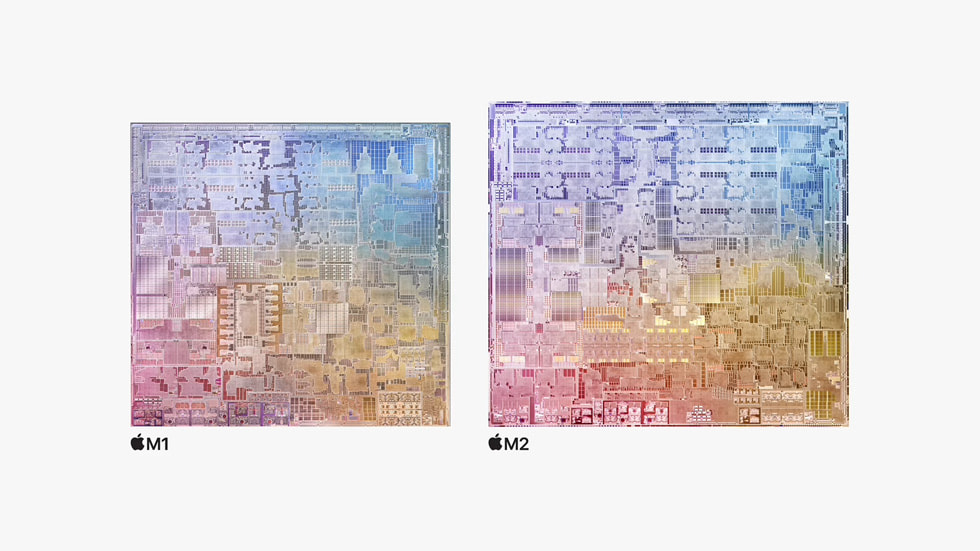Apple M2 Family SoC Overview and Performance Analysis
Apple’s M2 series represents the second generation of Apple Silicon chips, building upon the M1 architecture introduced in 2020. Manufactured using TSMC’s enhanced 5-nanometer process (N5P), M2 chips include roughly 20 billion transistors—approximately 25% more than the M1—while preserving Apple Silicon’s notable power efficiency.

M1 & M2 chips via Apple.com
Normalized Combined Geekbench Scores* Across SOC Generations
+25% faster
than prev. gen.
Rather than shifting to a smaller manufacturing node, the M2 architecture refines the existing design, incorporating higher clock speeds and enhanced GPU capabilities. Apple claims up to 18% CPU and 35% GPU improvements compared to the M1.
The M2 family includes four variants: M2 Base, M2 Pro, M2 Max, and M2 Ultra, each offering progressively higher performance levels. The Base M2 features an 8-core CPU (4 performance cores, 4 efficiency cores), up to a 10-core GPU, and 100 GB/s unified memory bandwidth.
The M2 Pro expands capabilities further with a 12-core CPU (8 performance, 4 efficiency), a 19-core GPU, and doubles memory bandwidth to 200 GB/s. The M2 Max elevates performance with up to a 38-core GPU and 400 GB/s memory bandwidth, supporting as much as 96 GB unified memory.
The M2 Ultra combines two M2 Max chips using Apple’s UltraFusion technology, featuring a 24-core CPU (16 performance, 8 efficiency), up to a 76-core GPU, and 800 GB/s memory bandwidth with support for 192 GB unified memory.
Our Geekbench benchmark data aligns closely with publicly available benchmarks, confirming consistent performance measurements. For example, the M2 Base scores 2,656 in single-core tests, aligning with public averages of 2,600–2,700. The multi-core score for the M2 Pro (14,624) also matches typical public benchmarks between 14,400–14,800. GPU Metal scores show similar consistency; our M2 Max GPU achieves 139,633, within the expected public range of 135,000–142,000.
Each M2 variant targets specific user needs and workloads. The M2 Base, ideal for everyday computing, powers devices like the MacBook Air and iPad Pro, delivering balanced efficiency and performance.
The M2 Pro suits power users, developers, and multimedia creators seeking enhanced multi-threaded performance in compact devices like the Mac Mini. The M2 Max targets intensive creative workflows such as video editing, 3D modeling, and high-performance computing, with significant GPU capabilities and expanded memory.
The M2 Ultra meets the demands of professional environments requiring advanced simulations, video production, and AI applications, offering desktop-level workstation capabilities.
The M2 series serves as an essential step in Apple’s silicon roadmap, bridging the innovative M1 and the forthcoming 3nm-based M3 chips. It provides performance upgrades, expanding versatility and reinforcing Apple’s leadership in performance-per-watt efficiency.
Interestingly, benchmark tests indicate that in specific GPU workloads, the M2 Pro can outperform its successor, the M3 Pro, emphasizing the optimized strength of Apple’s second-generation silicon.
A notable quirk of the M2 is its memory architecture. Although it upgrades to LPDDR5-6400 memory (theoretically 100 GB/s), it retains the 128-bit bus from the M1, placing its raw bandwidth between the M1 (LPDDR4X-4266, ~68 GB/s) and the M1 Pro/Max (256-bit LPDDR5, ~200 GB/s). Consequently, certain memory-intensive tasks can see an M1 Pro outperforming the newer M2.
Additionally, the baseline power draw of the M2 family varies significantly, with the M2 Base idling around ~7 W and peaking near ~50 W. The M2 Pro maintains a similar idle at ~7 W but can reach ~100 W under load. The M2 Max idles slightly higher at ~9 W and peaks around ~145 W, whereas the M2 Ultra, designed for high-performance workloads, idles at ~10 W and can peak at approximately ~295 W.
The enhanced GPU of the M2 (approximately 30% better than M1) adds about 2 W to idle power consumption, prompting fan activation under modest graphics workloads. This shift underscores Apple’s adjusted strategy to prioritize sustained performance over ultra-low power idling.
Normalized Combined Geekbench Scores* Across SOC Generations
+13% faster
than prev. gen.
Ultimately, the M2 represents a significant evolution in Apple’s SoC technology, combining substantial performance and efficiency gains, reinforcing Apple’s ongoing commitment to innovation in silicon technology.
Checkout a 3-way comparison between low, mid, and high-end M2 Macs.
